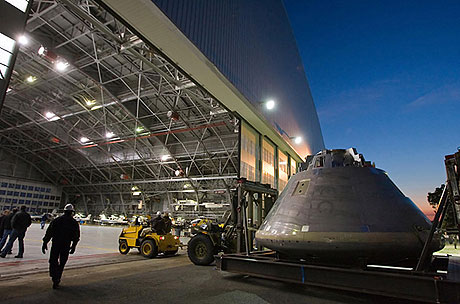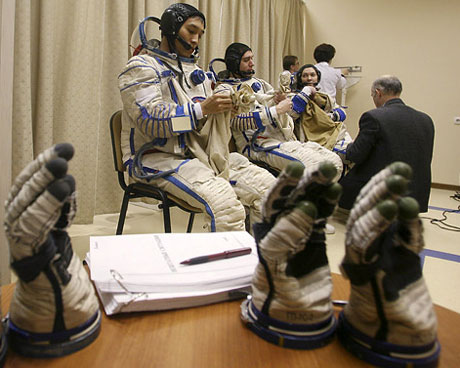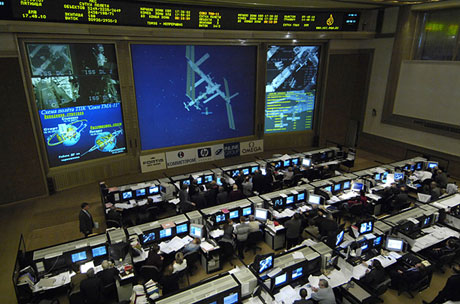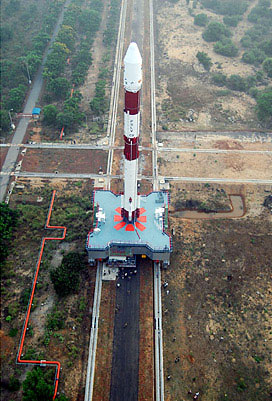Hot race to the Moon
The two countries pioneering in conquering space in the US and Russia are joining new faces of this work such as Europe, China, India and Japan announcing plans to re-land on the Moon by 2020.
America
Model of the new generation Orion spacecraft compartment at NASA's Langley Research Center, Virginia State. At the end of 2008, Orion's actual model will be included in a test launcher, to test the emergency escape system for astronauts on the spacecraft. The United States is hoping to bring people by Orion to ISS International Space Station before 2015 and return to the Moon since 2020.

Russia
The astronauts train at the Star City space center, a suburb of Moscow, in early 2008. Russia is hoping to bring people to the Moon by 2025.

Technical experts from Russia's control center in Korolev are monitoring the screen of the ISS International Space Station.

India
The PSLV C-9 rocket is being transported to the launch site at Sriharikota space center, near Chennai, April 2008. On October 21, India's ambitious space program went a step further with the launch of the Chandrayaan-1 unmanned moon probe with a similar rocket.

China
China's first astronaut Yang Loi Wei prepares to board the Shenzhou V ship, carrying out a history of helping the country become the third country in the world to bring people into space after Russia and the United States, 2003 .

The second Shenzhou VI spacecraft brought Chinese people into space at an assembly plant in Jiuquan, just before the flight in October 2005. China claims it wants to fulfill its mission to bring people to the Moon by 2020.

The golden halo of smoke radiated when the Shenzhou VII ship carrying 3 Chinese astronauts left the ground, in September 2008, carried out the mission for the first time this country took people to walk out into space . ( Photo: Xinhua)

Japan
The Japanese H2-A missile is leaving the launch pad at Tanegashima Space Center in Kagoshima Prefecture. The island nation announced plans to start bringing people to the Moon by 2025.

Europe
Astronaut Hans Schlegel, a German, of the European Space Agency (ESA) is working outside the Columbus module on the ISS station. This module contains a laboratory, which has 10 compartments the same size as a public telephone booth. Each of these compartments can act as an independent laboratory doing experiments in areas such as biology and physics . serving Europe's space conquest mission.

Technical experts at the control room of the European Space Agency Control Center (ESA) are located in the city of Darmstadt, Germany. ESA is a joint organization of 17 European countries dating back to 1974. ESA now focuses on developing technologies for the mission to bring people to Mars in the future.

- The first race on the Moon may take place next year
- Engineer John Houbolt: The masked man helps America win the Moon race
- Audi makes autonomous vehicles for the Google Lunar X-Prize race
- Hot universe race in Asia
- Moon exploration race
- Why did the former Soviet Union fail in the race to the Moon?
- Japan - China race to the moon
- Easy to 'race' up space
- Does the Moon have its own moon? And you will be surprised with its name!
- Russia announced the race to build the Moon space station
- Russia wants to help America explore the Moon
- The tragedy hidden after the moment the US landed on the Moon: The astronaut's body could not be identified!
 Van Allen's belt and evidence that the Apollo 11 mission to the Moon was myth
Van Allen's belt and evidence that the Apollo 11 mission to the Moon was myth The levels of civilization in the universe (Kardashev scale)
The levels of civilization in the universe (Kardashev scale) Today Mars, the sun and the Earth are aligned
Today Mars, the sun and the Earth are aligned The Amazon owner announced a secret plan to build a space base for thousands of people
The Amazon owner announced a secret plan to build a space base for thousands of people